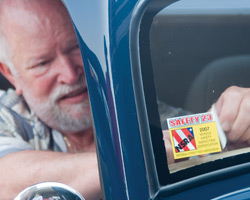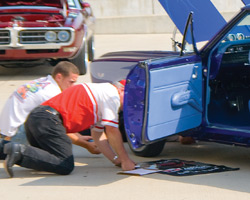
The specialty vehicles NSRA members own are built to be driven on the streets and highways. They are used to transport people, often to far off locales for recreational enjoyment.
The National Street Rod Association® is dedicated to vehicle safety and backs it up with a program that gives every owner the opportunity to have his/her vehicle safety inspected for free as often as they want with a strong emphasis on having it done at least once each year.

The NSRA Vehicle Safety Inspection Program is completely voluntary, and includes 23 different items ranging from the lighting system to suspension (see list that follows), and the sole purpose of the safety inspection is to advise the vehicle owner of problem areas, either real or potential.
As an “advisory” type inspection, it is only used to call the owner’s attention to something which may have been overlooked. The inspection is not mandatory and has no effect on entering or taking part in NSRA events.
Even though this program is totally voluntary, the number of vehicles inspected grows every year. The NSRA Vehicle Safety Inspection is offered at each of the thirteen annual NSRA events, and at hundreds of independently produced activities all across the country.
The program has become so popular, in fact, that each spring there is a growing number of “Safety Runs” where the main theme is only the Safety Inspection to make sure the vehicles are ready for another season of trouble-free, safe fun.

While more and more specialty vehicle owners recognize the benefits of having their vehicles safety inspected every year, there is one group of them that is even more keenly aware of the program’s value; the guys and gals that make up the all volunteer NSRA Safety Inspection Teams.
There is one of these teams in every state, and in areas where the number of enthusiasts is more heavily concentrated there are additional teams so that as many of them as possible will have the opportunity to take advantage of the safety teams’ services and expertise.
These Safety Inspection Teams are providing a very worthwhile service for the National Street Rod Association, but what they are offering for free to the individual enthusiast is much more important…an extra set of eyes to notice a potentially life threatening condition before it becomes more of one.
There are approximately 800 people involved in making the NSRA Vehicle Safety Inspection Program work, and they are doing more than just talking about vehicle safety…they make it a reality!
Considering the number of miles street rodders accumulate year after year on their street rods, this is a very safe hobby. With the emphasis NSRA puts on safety combined with the care street rodders put into their vehicles when constructing and maintaining them and the services provided by the NSRA Safety Inspection Teams, there is every reason to believe it will remain a safe hobby well into the future.
While attending an NSRA National event, take a few minutes to visit the Safety Inspection Area and learn a little more about this great program first hand…take the time to have your vehicle safety inspected…or simply note the number of NSRA Safety Inspection Verification Stickers on the windshields of the vehicles you look at.
Vehicle safety is an important part of our hobby and most all enthusiasts recognize that fact and are doing something to prove it… they are having their vehicle safety inspected every year.
Vehicle Safety Inspection Requirements
Required Equipment
- Horn: Electric only.
- Speed Indicator: Speedometer or calibrated tachometer at 65 mph.
- Rear View Mirror: One inside or outside on driver’s side of vehicle.
- Glass: Must be safety plate, lexan, or tempered glass.
- Lighting: Hi-beam; low-beam; tail; brake; license.
- Windshield Wiper: Electric or vacuum operated.
- Automatic Transmission Lockout: Neutral and/or park start only.
- Tires: 3/32 tread acceptable. Must meet D.O.T. specifications.
- Steering No excessive “play” (2″ radius max.) or binding; system must be safely mounted.
- Throttle Linkage: Must not travel past center.
- Fuel System: Check Vent on Trunk and Interior Mounted Tanks; no clear, plastic lines allowed. No leaks.
- Exhaust System: No Leaks: Must pass rear edge of front door and exit exhaust away from vehicle.
- Self-aligning Rod End Bearings: Check for fractures, insert sloppiness or binding.
- Shock Absorbers: One per wheel, no leaks, 2″ travel in each direction.
- Brakes: Four-wheel brakes, no leaks, check brake pedal travel, no copper tubing, check length of flexible lines.
- Scrub Line: No steering, suspension or chassis components should be below this line.
Recommended Equipment: May be reason for failure
- Windshield: Should be AS-1.
- Shift Pattern: Shift pattern should be visible except on three speed standard column shift.
- Fuel Lines: Should be safely mounted and routed.
- Parking Brake: Should be activated independent of vehicle’s hydraulic system.
- Self-aligning Rod End Bearings: Ball should have 1/8 inch spacer on each side of the ball if there is any misalignment. Rod ends should not have more than 10° misalignment. ROD ENDS and 4 BAR-PARALLEL RADIUS ROD SYSTEM rubber bushed ends should have a safety washer at least the same outside diameter as the housing or larger.
- Brake Lines: Should be safely mounted and routed.
- Chassis Fasteners: Self-locking nuts, lock-washers, safety wire, or cotter pins.
For Your Safety
- Safety Equipment: Fire extinguisher in driver/passenger compartment, seat belts, a third brake light and a dual master cylinder.
Disclaimer
Completion of the NSRA vehicle inspection warrants only that the vehicle complies with equipment requirements recommended by the National Street Rod Association.
The National Street Rod Association vehicle safety inspection is only advisory and is not to be construed as an official legal clearance, and the National Street Rod Association, its employees, officers, delegates, agents, or anyone assisting the Association assumes no responsibility for this advisory clearance.



